Looking for the best glass baby bottles for your baby? Here’s what you need to know!
Choosing the safest and healthiest products for your little one is always a top priority. From non-toxic toys and flame-retardant-free car seats to baby bottles and bassinets, every decision matters when it comes to nurturing your baby’s health and well-being.
And when it comes to feeding, one of the most critical choices you’ll make is selecting the right baby bottle. Not only are you looking for a safe baby bottle, but you’re also looking for one that your baby will take well to. There’s a lot to consider when choosing a bottle, and it might require a little trial and error.
But, one of the most important things I want you to know is that plastic and silicone baby bottles are not healthy choices for your baby. FOr such a critical period of your baby’s development, it’s best to use clear, unmarked glass baby bottles. This is truly the best choice for a non-toxic baby bottle!
Read on to find out why clear, unmarked glass baby bottles are the healthiest and most non-toxic baby bottles, plus find out our picks for the best glass baby bottles for your sweet baby.
Why Are Unmarked Glass Baby Bottles the Safest Choice?
When it comes to choosing which baby bottles to give your baby, you have several different options: plastic baby bottles, glass baby bottles, hybrid baby bottles, silicone baby bottles, and stainless steel baby bottles. But not all of these are equal as far as health and safety go. Of all these options, the safest and healthiest type of baby bottle is one made from clear glass, with no paint or markings on it.
❌ Plastic Bottles: While plastic bottles can seem convenient, they can leach microplastics and harsh chemicals into your baby’s milk or formula (including bisphenols and other endocrine disruptors). Given how frequently your baby will be given a bottle, and considering that milk or formula are served warm, plastic bottles are simply not worth the risk. AVOID.
❌ Silicone Baby Bottles: Silicone baby bottles are slightly better than plastic, simply because silicone tends to be more stable than most conventional plastics, but this is still not an ideal choice because silicone can still leach at certain temperatures. Additionally, the material is synthetic and silicone is not an optimal material for heating or serving breast milk or formula.
❌ Stainless Steel Baby Bottles: Stainless steel bottles are a better option to consider than plastic or silicone, especially in situations where bottles must be sent to a caregiver or daycare that doesn’t allow glass bottles (though we still strongly believe this concern is unfounded). Stainless steel offers slightly less temperature regulation than glass, and is slightly more risky in the event that your baby has a nickel allergy, so factor that in when choosing a bottle type.
Out of all the options you have for baby bottles, clear, unmarked glass baby bottles stand out as the safest choice. Let’s go into the reasons why glass bottles are the best choice for non-toxic baby bottles:
✅ Glass baby bottles don’t contain the kinds of harsh, unhealthy chemicals found in other types of bottles. Unlike plastic bottles, glass baby bottles are free from harmful chemicals such as BPA (bisphenol-A) and its sister chemicals, phthalates, PVC, and other potentially harmful substances. These chemicals can leach into the contents of plastic bottles, especially when heated, posing a serious risk. Glass bottles provide peace of mind, ensuring that your baby’s milk or formula remains pure and uncontaminated.
✅ Glass baby bottles aren’t likely to leach. Unlike plastic or silicone, glass is non-porous and won’t absorb odors, flavors, or colors from liquids. This means that glass baby bottles won’t alter the taste or smell of your baby’s milk, ensuring a consistent feeding experience every time. Have you ever heard that baby food served on silicone plates tastes like soap? The same can happen with silicone baby bottles.
✅ Glass baby bottles are highly durable. You might assume that a glass baby bottle is more likely to break, which would pose a safety hazard. But, glass baby bottles are incredibly durable and long-lasting. High-quality tempered glass is designed to withstand thermal shock and is resistant to breakage, making it a reliable choice. In fact, after using glass bottles with both of my babies, I can report that I never had a single one break!
✅ Glass bottles are easier to clean. Glass bottles for the win in this category! They are so easy to clean and sterilize. Unlike plastic bottles, which can develop scratches and harbor bacteria over time, glass bottles can be cleaned or sanitized without worrying about the material degrading. They can be safely washed by hand or in the dishwasher. Plastic should ideally not be run through the dishwasher anyway, making it even harder to clean plastic baby bottles properly.
Toxins Found in Baby Bottles
Oh, the history of toxins in baby bottles. It’s not pretty.
BPA in baby bottles? Years ago, plastic baby bottles were made with BPA, an estrogenic endocrine-disrupting chemical that is linked with numerous health issues. However, BPA in baby bottles has since been banned in the United States, though you can still find plastic baby bottles that contain BPA in some developing countries.
Even though BPA has been banned from baby bottles, though, remember that “BPA-Free” doesn’t mean “safe.” When BPA is removed, it’s simply replaced with another equally concerning chemical like BPS. So, don’t fall for the misleading greenwashing of packaging that says “BPA-Free”!
Lead in glass baby bottles. I’m going to throw you a slight curveball here. Glass is still, in our opinion, the safest material for baby bottles. But, you should know that some glass baby bottles have been found to contain lead in the exterior paint and markings in a 2024 study conducted by Mamavation and DetectLead. These bottles tested positive for lead in the exterior paint at levels above and below the legal limit for lead in baby and children’s products (0.009 percent by weight of the total nonvolatile content of the paint or 90 ppm parts per million.)
So how does this happen? Clear glass isn’t a concern for lead or other contaminants in and of itself, but when companies add paint to the bottle, they are using materials that may vary in quality. In fact, 91% of the bottles Mamavation tested had detectable levels of lead in the print or design (it was 22 out of 24 bottles including brands like Lansinoh and Dr. Brown’s).
There are two other key takeaways from this study. One is that the lead was found through UV testing to transfer to the user’s hands, meaning that these high levels are highly risky for parents and babies alike. The other thing to know is that the plastic bottles that they tested came back ND/non-detect for lead. Why is this? It’s likely because the process of applying paint to a glass bottle is different than plastic. STILL, this doesn’t change our recommendation to include plastic bottles. It’s just an interesting factoid that we’re nerding out on.
The Best Glass Baby Bottles
These are our top choices for a non-toxic baby bottle. These are glass baby bottles that contain no outside designs, or paint markings (with one exception). These results factor in the XRF test results from Mamavation’s study, when applicable.
1 | Evenflo Glass Baby Bottles
Evenflo glass bottles are a great choice for your baby! These bottles feature a unique, ergonomic shape that’s actually really fun and easy to hold. These are great for directly pumping into, and you can also rest assured that there aren’t tons of parts to clean… with only 3 parts, you will appreciate that when it comes time to wash your baby bottles.
Evenflo gets our top spot for the best glass baby bottles because their bottles are free from any paint and designs. They’re just made from good old glass, which is what we want to see. Buy these with confidence.
2 | Lifefactory Glass Baby Bottles
Lifefactory bottles are highly durable and can be used in the freezer because they’re made from thermal shock-resistant borosilicate glass (sourced from France). Each of these bottles comes with its own medical-grade silicone sleeve and stage 1 silicone nipple for newborns (age 0-3 months). While the Lifefactory bottles are a bit on the expensive side, they are comparable to other brands when you factor in the additional cost of the silicone sleeves, and Lifefactory bottles make a good investment because they transition to sippy cups for when your baby gets older.
All parts are made in the US or Europe and are BPA/BPS-free and phthalate-free. To wash, you simply remove the sleeve (when desired) and wash both the bottle and the sleeve in the dishwasher or boil both parts on the stove. This brand is fast growing in popularity and is definitely worth considering.
These bottles are also sold in a set of two. (Note: some parents have reported poor ventilation with these bottles. If you experience some issues with this, including gassiness or fussiness, you may be able to use Dr. Brown’s anti-colic venting insert with these bottles. It’s a hack that might be worth trying because the quality of the Lifefactory bottles is superior to the Dr. Brown’s bottles.) These bottles also come in a 9 oz version.
These were not tested under and XRF machine, but they do not contain any exterior paint or designs, so I would still consider these a great choice for non-toxic baby bottles.

Buy on Amazon
3 | The Mason Bottle
Are you looking for a super simple glass baby bottle that’s also incredibly versatile? Consider the Mason Bottle. Using a really simple concept, the Mason Bottle offers you the strength and durability of a mason jar with the size and convenience of a baby bottle.
The company also makes breast milk storage jars and other products for your baby as they grow into toddlerhood. Moms who use these usually love them!
Buy on Amazon | The Mason Bottle
4 | Chicco Duo Glass Bottles
Chicco has created a unique take on glass baby bottles with the Duo Glass Bottles. With plastic on the outside, and glass on the inside, these bottles offer the durability of a plastic bottle with the chemical safety of a glass bottle.
Many mamas love these bottles for that very reason — they’re incredibly innovative and give you the best of both worlds! Although they were not tested in the 2024 Mamavation study, I feel comfortable recommending these, considering that they contain a plastic exterior and plastic didn’t test positive for lead. However, it’s best to exercise caution when handling the glass portion of these bottles because the paint may rub off onto your hands or in the dishwasher.
Buy on Amazon
Other Glass Baby Bottles to Consider
These products tested clean (non-detect) in Mamavation’s study on lead in baby bottles, but they do have external paint markings. While they tested lead-free, I think the brands listed above are a better choice considering that they do not contain any external paint markings. My main concern is that future production lots of these products might test differently (i.e. be positive for lead) considering that they contain paint markings.
- NUK Simply Natural Glass Bottle. These NUK bottles are very durable and well-liked by parents and babies alike. While the bottles are heavily marked and contain a NUK logo on the front, they tested ND negative for lead using the XRF machine.
- MAM Feel Good Glass Bottle. This is a loved brand of glass baby bottles. Many have had success with MAM bottles, even when their baby wouldn’t take other bottles. It has cute designs on the bottle, and it didn’t test positive for lead. Still, I prefer the bottles listed above that don’t contain external paint markings on the glass. This brand has also tested poorly in past years.
The legal limit for lead in children’s products is 90 ppm, and the following products tested positive for lead at least once in Mamavation’s testing — but were far below the legal limit. I would 100% still recommend the brands listed above before these products, but I think these still warrant a place on the list and I want you to decide. I just wish these brands would stop painting their logos and markings on the bottles!
- Natursutten Glass Baby Bottles. Featuring a slow-flow, natural rubber nipple, Natursutten is a cool and unique option for your glass baby bottles. The anti-colic valve helps ensure a smooth flow of milk or formula to your baby, reducing the possibility of gas and digestive upset from bottle-feeding. If you’re on the hunt for a good glass baby bottle, and you haven’t quite found “the one” that works for you, consider trying the Natursutten bottles. A lot of parents have had success with these bottles (thanks in particular to the anti-colic features), when other popular brands haven’t worked for their baby. These bottles unfortunately have a large Natursutten logo on them and did test positive in one lead test (though the results were quite low, comparatively, and below the legal threshold).
- Gulicola Glass Baby Bottles. Made with borosilicate glass, Gulicola baby bottles are growing in popularity. They come in multiple sizes, ranging from 3 oz. to 9 oz., giving you different options at each stage of your baby’s growth. Mamas love that the nipples offer a nice, slow-flow, making this a good choice for babies with reflux, tongue ties, or other reasons to go with a slower-flow nipple. These bottles did have a positive test result for lead (on the very low end of the spectrum and below the legal limit) in the Mamavation study.
- Dr. Brown’s Glass Bottles. Designed to be anti-colic, Dr. Brown’s have been a popular choice among parents for many years. Many lactation specialists also recommend this brand because their nipples provide the best flow for newborns and preemies. (Hint: if you’re nursing and giving baby expressed milk in a bottle, try the preemie flow nipples for your newborn to slow down the flow to most closely match the natural flow of your breasts.) These are the bottles that we used with my first, and I was mostly happy with them except for a few complaints: the anti-colic parts are made from plastic, are challenging to wash, and sometimes leak. The other problem is that they did have a positive test for lead on Mamavation’s study. Based on this, you might be wondering why I put up with these bottles or why I would recommend them. The answer is simple – they do a good job of reducing air intake, which helps babies who are prone to colic, reflux, or gas. If your baby experiences colic, gas, or just a lot of discomfort in his early days, you may want to try Dr. Brown’s Bottles. To mitigate the lead concern, I would consider using silicone sleeves for their bottles, but please note that doesn’t fully prevent exposure.
- Tommee Tippee Closer to Nature Glass Baby Bottles: If you like the shape of Tommee Tippee bottles, you are in luck because they now make glass bottles, too. They are a little on the heavier side, but the glass is very durable and the bottles should hold up for a very long time. The design is also supposed to mimic breastfeeding, so this could be a good option for a glass bottle for breastfed babies, too. Many mamas who use this brand say they interchange between nursing and bottle feeding without any issues, so that is definitely something to consider if you are doing both!
- Philips AVENT Natural Glass Bottles. Philips Avent bottles come with a breast-shaped nipple that is also designed to prevent babies from swallowing air to reduce colic and gas. Philips offers various nipple flow options that are designed to slow down or speed up baby’s intake of milk, based on their age and needs. The bottle itself has an ergonomic design, which makes it easy and comfortable to hold. I loved these bottles personally. They tested ND non-detect once, but did have a positive result for lead in the markings in a second test.
Tips for Buying Baby Bottles
- Quantity. Be prepared to try more than one brand of baby bottle in the event your baby doesn’t take well to the one brand you prefer. Be patient and gently keep trying, even when your baby refuses a specific brand of bottle.
- When to Give a Bottle. Most lactation consultants will advise moms to begin introducing a bottle at around 4-6 weeks of age, which is long enough to prevent nipple confusion and also early enough in baby’s life to ensure that they will accept a bottle.
- Bottle Size. Most newborns will only need a 4 oz. bottle at first, but you can graduate to the larger 8 oz. sizes if your baby continues to take a bottle as they get older. If you’ll be giving any formula, you might find it easier to use wide-mouth bottles like the ones made by Philips Avent.
- Nipple Flow. Unless your doctor or lactation specialist has recommended otherwise, start your newborn with the slowest flow nipple available by the bottle manufacturer you’ve chosen. As your baby grows, you can transition to age-appropriate nipples, which will gradually provide a faster flow. Almost every lactation specialist I spoke with recommended Dr. Brown’s Preemie Nipples.
Baby Bottle Accessories You Might Need
In addition to buying non-toxic baby bottles, you may need some of these additional products when bottle-feeding.
Bottle Drying Racks
If you’ll be hand-washing bottle and breast pump parts (hint: you will be), you’ll want to have a bottle drying rack on hand — or a good dish rack. This is one category of baby products that hasn’t yet been perfected, so the options are pretty limited and unfortunately leave much to be desired. (The Boon grass-like drying rack is very popular but is poorly designed – it’s a breeding ground for bacteria and gunk, so I strongly recommend against this popular choice.)
Consider the Munchkin High Capacity Drying Rack, which can store up to 16 bottles and gets good reviews for being sturdy, having a handy drain and flexible prongs, and being able to store many bottles and parts at the same time.
Parents also love the Boon Spring Drying Rack, which can hold up to 8 bottles and has a drip tray at the bottom. OXO’s Tot Bottle and Accessories Drying Rack (I love this one!) gets great reviews for its convenient design and sturdiness. You can also use a travel drying rack for when traveling with your baby.
Baby Bottle Brushes
One item that many new parents forget to purchase is a bottle brush. While it’s important to sanitize your bottles before their first use, this isn’t necessary on a daily basis (unless medically advised), so you’ll want to have some bottle brushes on hand to help you keep your baby’s bottles clean.
I prefer a bottle brush that will stand on its own with a suction cup, and Dr. Brown’s Bottle Brush is a good option for most bottles, and so is the Munchkin Bristle Bottle Brush, although it may not fit all bottles. The Munchkin brush is dishwasher safe, so that makes it a big win in my book!
Both options come with a smaller brush for cleaning nipples, straws, and breast pump parts, but I would also recommend having the Munchkin Bottle Cleaning Brush Set on hand, too.
Bottle Sanitizers
This is one piece of baby equipment that you can skip.
When you sanitize bottles and pacifiers, just throw them in some boiling water on the stove for 3-5 minutes (please follow the manufacturer’s advice for your specific product). Glass bottles can also be sterilized in the dishwasher.
There’s really no need to purchase additional equipment unless your pediatrician has recommended sterilizing baby’s bottles before each use for medical reasons, in which case you might need to get a sanitizer. Just make sure to avoid any sterilization techniques that involve your microwave, as it is not only unsafe to heat plastic in the microwave, it’s best to avoid microwave use and exposure whenever possible.
Instead, consider the Philips AVENT Electric Steam Sterilizer, which runs at a higher temperature than dishwashers, works in 6 minutes, has an automatic shut-off, and keeps items sterilize for up to 24 hours if the lid remains unopened.
Please be sure to follow the manufacturer’s instructions for cleaning your sterilizer.
If you found this guide to the best glass baby bottles helpful, save it for later!

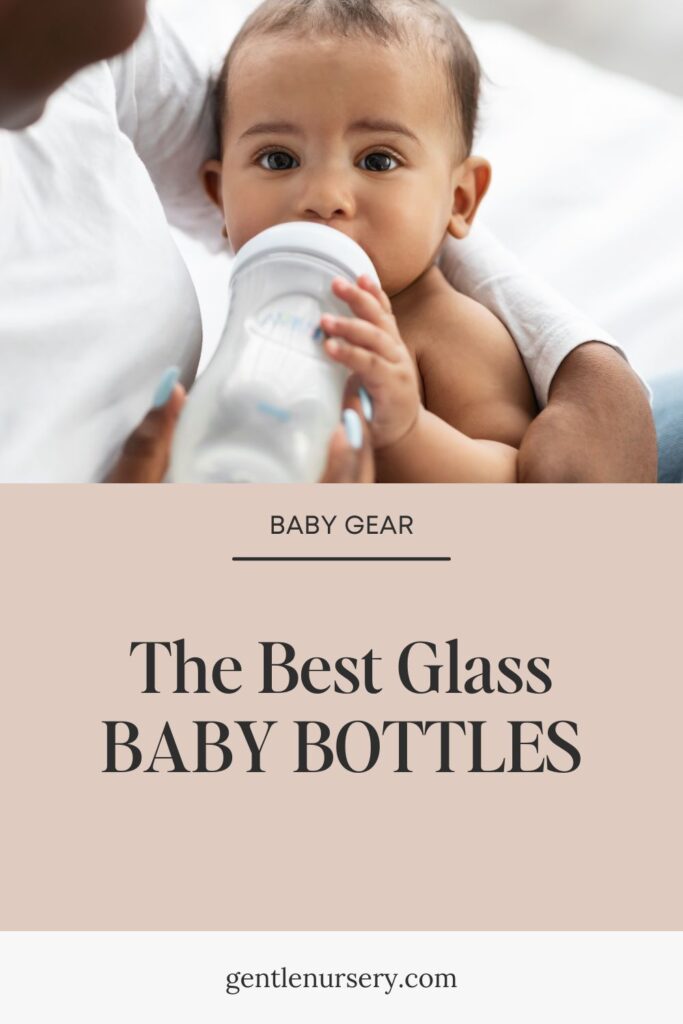
You Might Also Like:


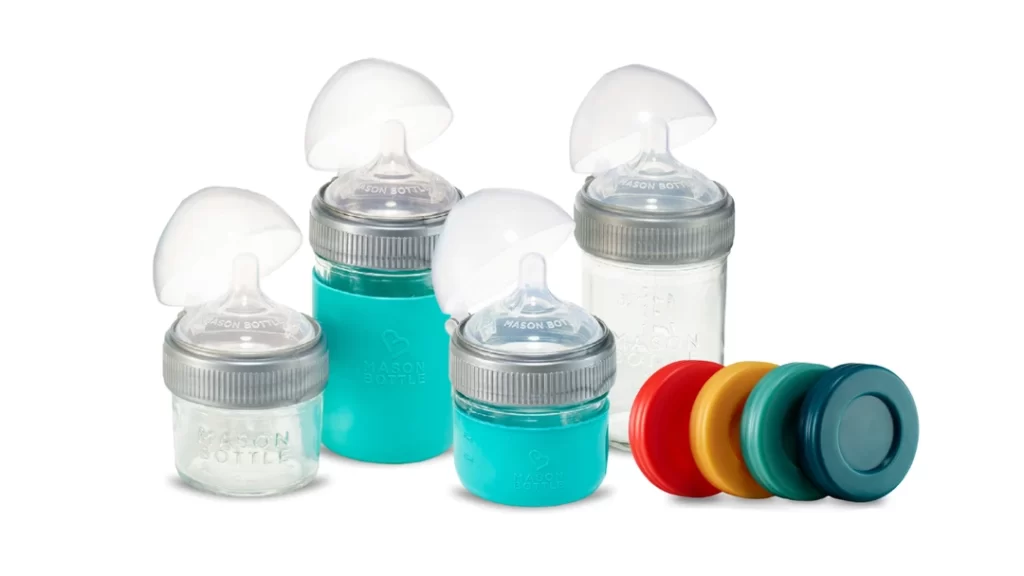

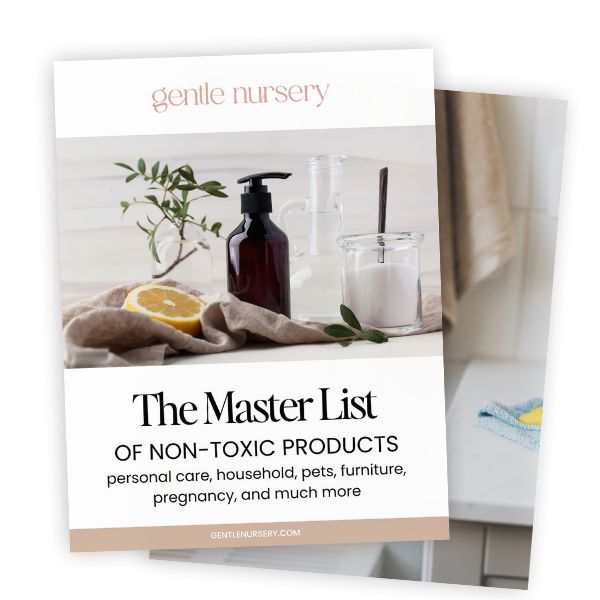
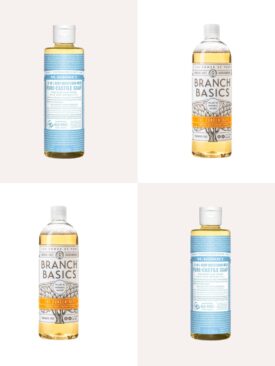
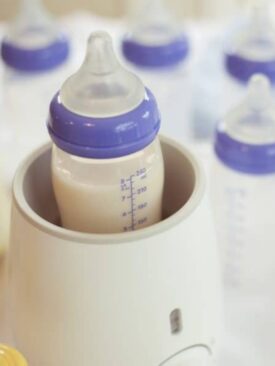
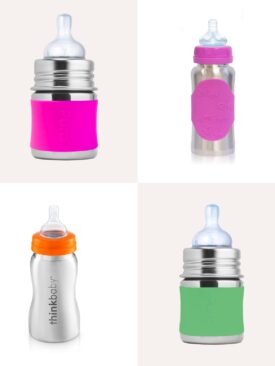
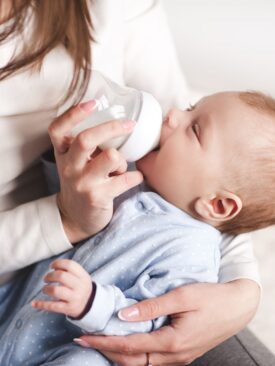
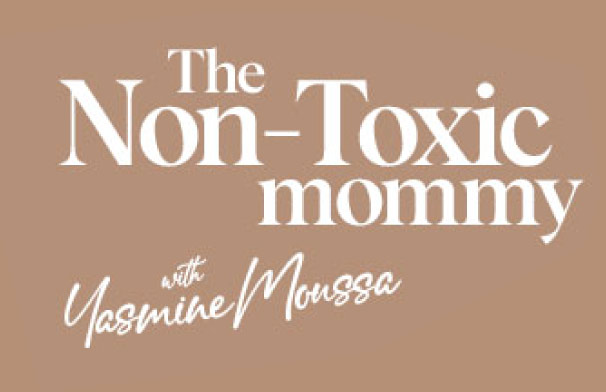
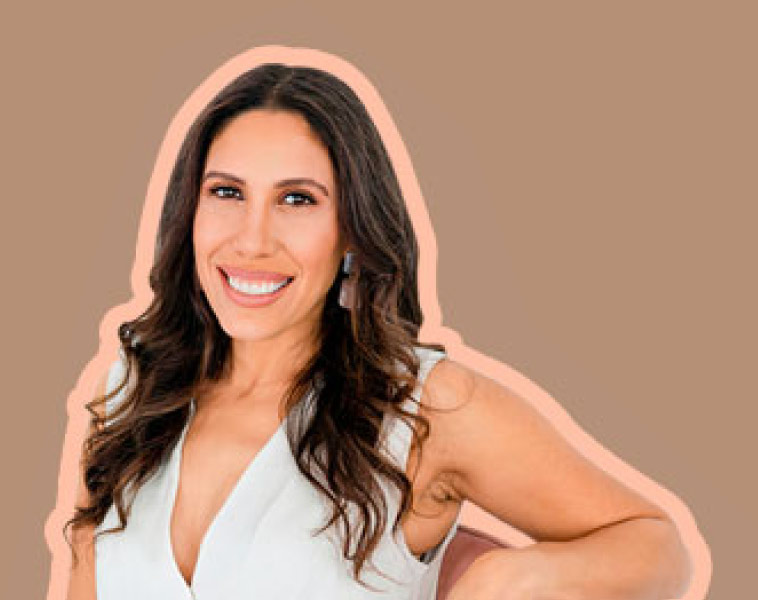
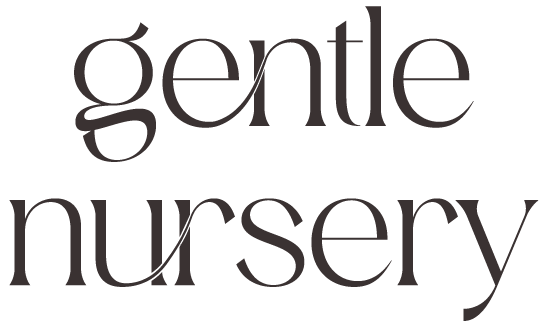
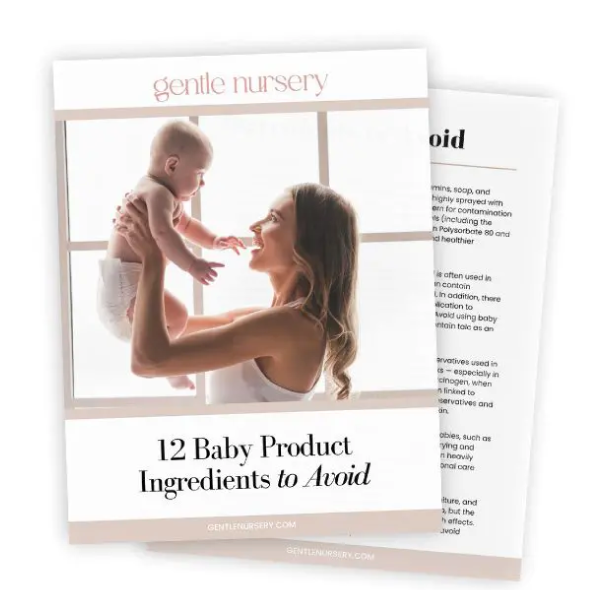
Hi
What do you think about UV sterilizers? Are they safe for silicone parts or would they promote leaching/breakdown?
I noticed you removed the evenflo glass bottles from your list of recommended bottles. Is there a reason why?
Hi! It should still be on there? This list needs to be updated but those bottles weren’t (intentionally) removed 🙂
Ok great! I was going to order more because my son prefers them. I just wanted to make sure you didn’t find out anything negative about the materials used to make them. Thanks so much! 🙂
What about special dish detergent for cleaning baby bottles? I’ve seen a few out there and already use EWG / Made Safe recommended dishwasher detergent and dish soap but didn’t know if we needed something more specifically sensitive for baby’s bottles. Thanks! Love your posts thank you so much for your time and efforts 🙂
Hi! And thank you! I would feel comfortable using Better Life, Puracy, or a Castile soap like Dr Bronner’s or MamaSuds. I also run mine in the dishwasher (we use better life dishwasher gel now). Thanks for using the site!
What is your go-to for pacifiers? Is medical grade silicone safe for babies?
It’s believed to be safe. I use soothies because that’s what my oldest took to. But it really comes down to what your baby will take so you might want to have a few different ones on your registry so you can try them out. Chicco also makes a silicone pacifier that is all one piece.